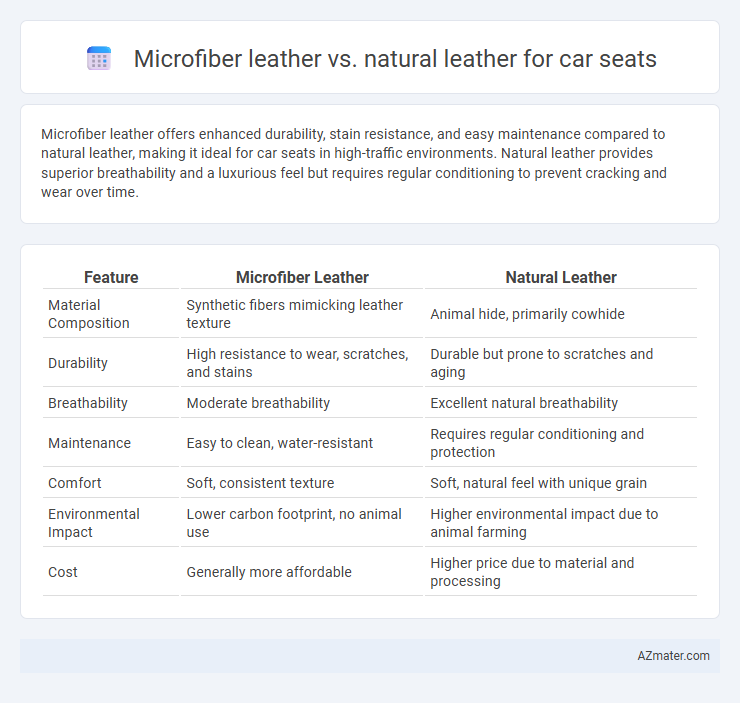Microfiber leather offers enhanced durability, stain resistance, and easy maintenance compared to natural leather, making it ideal for car seats in high-traffic environments. Natural leather provides superior breathability and a luxurious feel but requires regular conditioning to prevent cracking and wear over time.
Table of Comparison
| Feature | Microfiber Leather | Natural Leather |
|---|---|---|
| Material Composition | Synthetic fibers mimicking leather texture | Animal hide, primarily cowhide |
| Durability | High resistance to wear, scratches, and stains | Durable but prone to scratches and aging |
| Breathability | Moderate breathability | Excellent natural breathability |
| Maintenance | Easy to clean, water-resistant | Requires regular conditioning and protection |
| Comfort | Soft, consistent texture | Soft, natural feel with unique grain |
| Environmental Impact | Lower carbon footprint, no animal use | Higher environmental impact due to animal farming |
| Cost | Generally more affordable | Higher price due to material and processing |
Introduction to Microfiber Leather and Natural Leather
Microfiber leather is a synthetic material crafted from ultra-fine polyester fibers combined with polyurethane, designed to mimic the texture and durability of natural leather while offering enhanced breathability and stain resistance. Natural leather, derived from animal hides through tanning processes, is renowned for its luxurious feel, durability, and ability to age gracefully, often preferred for premium car seat upholstery. Microfiber leather presents a cost-effective, vegan-friendly alternative with consistent quality and easier maintenance, whereas natural leather provides unmatched authenticity and a unique patina over time.
Composition and Manufacturing Processes
Microfiber leather is composed of synthetic fibers such as polyurethane and nylon, engineered through a multi-layer coating process that mimics natural leather's texture and durability. Natural leather originates from animal hides, undergoing tanning processes like chrome or vegetable tanning to transform rawhide into a flexible, durable material. The manufacturing of microfiber leather offers enhanced resistance to stains and fading compared to natural leather, which requires more intensive preservation and care due to its organic composition.
Durability and Longevity Comparison
Microfiber leather offers superior resistance to scratches, stains, and UV damage compared to natural leather, making it more durable for long-term car seat use. Natural leather, while luxurious and breathable, tends to develop cracks and wear over time if not meticulously maintained, impacting its longevity. Microfiber leather's synthetic composition provides consistent durability and easier upkeep, resulting in extended lifespan under daily automotive conditions.
Comfort and Feel: User Experience
Microfiber leather offers a smooth, consistent texture that remains soft and breathable, enhancing comfort during long drives and reducing sweat accumulation compared to natural leather. Natural leather provides a luxurious, supple feel that molds to the body over time, delivering a unique tactile experience but can become hot and sticky in warm weather. Both materials contribute to comfort, with microfiber leather excelling in temperature regulation and maintenance, while natural leather offers premium softness and aging character.
Aesthetic Appeal and Customization Options
Microfiber leather offers a consistent, smooth finish with vibrant color options and intricate texture patterns, enhancing a modern and stylish car seat aesthetic. Natural leather provides a classic, luxurious appearance with unique grain variations and a rich patina that develops over time, adding character and exclusivity. Customization options for microfiber leather include a wider range of colors and embossed designs, while natural leather allows for hand-stitched detailing and dye treatments that emphasize its organic beauty.
Maintenance and Cleaning Requirements
Microfiber leather requires less maintenance than natural leather, as it resists stains and does not need regular conditioning to prevent cracking. Cleaning microfiber leather involves simple wiping with mild soap and water, avoiding harsh chemicals that can degrade its surface. Natural leather demands frequent conditioning with specialized products to maintain suppleness and requires careful cleaning to prevent discoloration and wear.
Environmental Impact and Sustainability
Microfiber leather for car seats offers a lower environmental impact due to its production process, which uses fewer natural resources and generates less carbon emissions compared to natural leather. It is typically made from synthetic fibers that are more sustainable and can be produced with less water and chemical usage, reducing its overall ecological footprint. Natural leather involves intensive animal farming, high water consumption, and chemical tanning processes that contribute significantly to environmental degradation and sustainability concerns.
Cost and Value Analysis
Microfiber leather offers a cost-effective alternative to natural leather, typically priced 30-50% lower while providing high durability and easier maintenance. Natural leather commands a premium due to its luxury appeal, longevity, and breathability but may incur higher expenses for cleaning and upkeep. Evaluating total ownership costs reveals microfiber leather delivers greater value for budget-conscious buyers without significantly compromising comfort or aesthetics.
Performance in Extreme Temperatures
Microfiber leather offers superior resistance to extreme temperatures, maintaining flexibility and durability in both high heat and freezing cold, unlike natural leather which can crack or stiffen under such conditions. Its synthetic composition allows for better breathability and moisture-wicking properties, reducing discomfort during temperature fluctuations. This makes microfiber leather a practical choice for car seats exposed to harsh climates while preserving aesthetic appeal and longevity.
Which is Better for Car Seats?
Microfiber leather offers superior durability, stain resistance, and easier maintenance compared to natural leather, making it a practical choice for car seats exposed to frequent use. Natural leather provides enhanced breathability, a luxurious feel, and timeless aesthetics but requires more care and is prone to scratches and wear over time. For car seats, microfiber leather is generally better suited due to its resilience and cost-effectiveness, while natural leather appeals to those prioritizing comfort and luxury.

Infographic: Microfiber leather vs Natural leather for Car seat
 azmater.com
azmater.com